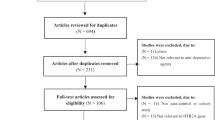Abstract
We investigated the effects of a 5-hydroxytryptamine (5-HT) 1A receptor gene polymorphism on the clinical response to fluvoxamine (FLV) in 65 depressed outpatients who gave written consent to participate in the study. Patients visited every 2 weeks after the first examination until the week 12 end point and were evaluated by the 17-item Hamilton Rating Scale for Depression (HAM-D-17) at each visit. FLV dose was changed in response to their clinical symptoms. The Gly272Asp polymorphism of the 5-HT1A receptor gene was identified by a PCR method. The subjects with the Asp allele had a significantly higher % reduction in the HAM-D-17 score than those with the Gly/Gly genotype at week 2 (P=0.009), week 6 (P=0.036), and week 12 (P=0.031). There was a significant difference in the genotype distribution between the responders and nonresponders. These results suggest that the Gly272Asp polymorphism of the 5-HT1A receptor gene may predict the response to FLV.

Similar content being viewed by others
References
Judd LL . Mood disorders in the general population represent an important and worldwide public health problem. Int Clin Psychopharmacol 1995; 10 (Suppl 4): 5–10.
National Advisory Mental Health Council. Health care reform for Americans with severe mental illnesses: report of the National Advisory Mental Health Council. Am J Psychiatry 1993; 150: 1447–1465.
Guscott R, Grof P . The clinical meaning of refractory depression: a review for the clinician. Am J Psychiatry 1991; 148: 695–704.
Blier P, de Montigny C . Current advances and trends in the treatment of depression. Trends Pharmacol Sci 1994; 15: 220–226.
Blier P, de Montigny C, Chaput Y . Modifications of the serotonin system by antidepressant treatments: implications for the therapeutic response in major depression. J Clin Psychopharmacol 1987; 7 (Suppl): 24S–35S.
Hyttel J . Pharmacological characterization of selective serotonin reuptake inhibitors (SSRIs). Int Clin Psychopharmacol 1994; 9 (Suppl 1): 19–26.
Hoyer D, Clarke DE, Fozard JR, Hartig PR, Martin GR, Mylecharane EJ et al. International Union of Pharmacology classification of receptors for 5-hydroxytryptamine (Serotonin). Pharmacol Rev 1994; 46: 157–203.
Artigas F, Romero L, de Montigny C, Blier P . Acceleration of the effect of selected antidepressant drugs in major depression by 5-HT1A antagonists. Trends Neurosci 1996; 19: 378–383.
Chaput Y, de Montigny C, Blier P . Effects of a selective 5-HT reuptake blocker, citalopram, on the sensitivity of 5-HT autoreceptors: electrophysiological studies in the rat brain. Naunyn-Schmiedeberg's Arch Pharmacol 1986; 333: 342–348.
Bel N, Artigas F . Chronic treatment with fluvoxamine increases extracellular serotonin in frontal cortex but not in raphe nuclei. Synapse 1993; 15: 243–245.
Fuller RW . Uptake inhibitors increase extracellular serotonin concentration measured by brain microdialysis. Life Sci 1994; 55: 163–167.
Rutter JJ, Gundlah C, Auerbach SB . Increase in extracellular serotonin produced by uptake inhibitors is enhanced after chronic treatment with fluoxetine. Neurosci Lett 1994; 171: 183–186.
Bordet R, Thomas P, Dupuis B . Effect of pindolol on onset of action of paroxetine in the treatment of major depression: intermediate analysis of a double-blind, placebo-controlled trial. Reseau de Recherche et d'Experimentation Psychopharmacologique. Am J Psychiatry 1998; 155: 1346–1351.
Perez V, Puiigdemont D, Gilaberte I, Alvarez E, Artigas F . Augmentation of fluoxetine's antidepressant action by pindolol: analysis of clinical, pharmacokinetic, and methodologic factors. J Clin Psychopharmacol 2001; 21: 36–45.
Nakhai B, Nielsen DA, Linnoila M, Goldman D . Two naturally occurring amino acid substitutions in the human 5-HT1A receptor: glycine 22 to serine 22 and isoleucine 28 to valine 28. Biochem Biophys Res Commun 1995; 210: 530–536.
Erdmann J, Shimron-Abarbanell D, Cichon S, Albus M, Maier W, Lichtermann D et al. Systematic screening for mutations in the promoter and the coding region of the 5-HT1A gene. Am J Med Genet 1995; 60: 393–399.
Kawanishi Y, Harada S, Tachikawa H, Okubo T, Shiraishi H . Novel mutations in the promoter and coding region of the human 5-HT1A receptor gene and association analysis in schizophrenia. Am J Med Genet 1998; 81: 434–439.
Nishiguchi N, Shirakawa O, Ono H, Nishimura A, Nushida H, Ueno Y et al. Lack of an association between 5-HT1A receptor gene structural polymorphisms and suicide victims. Am J Med Genet 2002; 114: 423–425.
Tome MB, Isaac MT, Harte R, Holland C . Paroxetine and pindolol: a randomized trial of serotonergic autoreceptor blockade in the reduction of antidepressant latency. Int Clin Psychopharmacol 1997; 12: 81–89.
Perez V, Gilaberte I, Faries D, Alvarez E, Artigas F . Randomised, double-blind, placebo-controlled trial of pindolol in combination with fluoxetine antidepressant treatment. Lancet 1997; 349: 1594–1597.
Acknowledgements
This research was supported by Grants-in-Aid for Scientific Research (KAKENHI) from the Japan Society for the Promotion of Research (JSPS) (#13670991 and #13671000).
Author information
Authors and Affiliations
Corresponding author
Additional information
DUALITY OF INTEREST
None declared.
Rights and permissions
About this article
Cite this article
Suzuki, Y., Sawamura, K. & Someya, T. The effects of a 5-hydroxytryptamine 1A receptor gene polymorphism on the clinical response to fluvoxamine in depressed patients. Pharmacogenomics J 4, 283–286 (2004). https://doi.org/10.1038/sj.tpj.6500256
Received:
Revised:
Accepted:
Published:
Issue Date:
DOI: https://doi.org/10.1038/sj.tpj.6500256
- Springer Nature Limited
Keywords
This article is cited by
-
Blood-based biomarkers predicting response to antidepressants
Journal of Neural Transmission (2019)
-
Review and meta-analysis of antidepressant pharmacogenetic findings in major depressive disorder
Molecular Psychiatry (2010)
-
How can we realize the promise of personalized antidepressant medicines?
Nature Reviews Neuroscience (2008)
-
Response to fluoxetine and serotonin 1A receptor (C-1019G) polymorphism in Taiwan Chinese major depressive disorder
The Pharmacogenomics Journal (2006)




